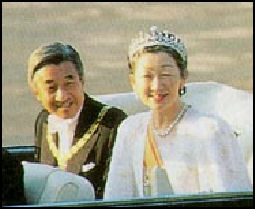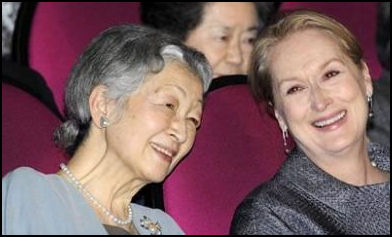EMPRESS MICHIKO

Empress Michiko was the first person of neither royal or aristocratic descent to become a member of the royal family. Although her family was not royal they were rich and well connected. Her father was Asia's richest flour and noodle maker. Two members of her family won the Order of Cultural Merit. Others were prominent scholars and business leaders. Many members of the Empress’s family were Catholics.
The Empress was born in Tokyo in October 1934. She studied English at Sacred Heart’s University. In her senior she was elected president of the student body and was valedictorian in her class.
Emperor Hirohito approved of the marriage but his wife Empress Nagako did not. As a commoner, Michiko helped make the royal family more like any other Japanese family and boosted the royal family's popularity. Her relationship with her mother-in-law — a formidable figure from the old aristocracy who looked own on the commoner princess — was notoriously unpleasant and stressful for her.
Empress Michiko has been described as "a gracious woman with a direct gaze, a kindly manner and a refined style." She is also very down to earth. She was the first empress to breast feed her own babies. She studied English at Seishin Women's University and graduated near the top of her class. She like to wear old-fashion hats.
She likes to play piano and wrote the story for the picture book “Hajimete no Yamanobori” ( — My First Mountain — ). Among her hobbies she lists the tea ceremony, poetry, playing music with members of her family, embroidery and flower arranging. She interested in children's liberation and supports court traditions such as silkworm cultivation and gagaku music. Empress Michiko is regarded as gifted poet who is known for expressing simple emotions in her work. Describing her experience as a new mother she wrote: “"Milk white spills from his mouth/ Clasped around my breast/ From his busy crimson lips." “ She also wrote: “"Although he is my own,/ I hold my child anxiously in my arms,/ Like a treasure I have been given."”
Kumiko Makihara wrote in the New York Times: “One morning late last month, the main street by my house was suddenly empty of traffic, and small crowds formed by the crosswalks where the pedestrian lights remained red. Empress Michiko was passing through town. As the motorcade rolled by, the empress delighted onlookers with a full view of her kind gaze, the window of her black sedan rolled down all the way. Empress Michiko nodded and smiled to passersby, looking beautiful and elegant, but with the soft creases in her face revealing a weariness of age. [Source: Kumiko Makihara, New York Times, May 27, 2010]
Emperor Akihito Marries Empress Michiko

The Emperor and Empress celebrate
their wedding anniversery In April 1959, Akihito he married Shoda Michiko (now empress Michiko). The two met playing tennis in the resort town of Karizawa. The were on opposing sides in a game of doubles. Michiko's team won the match in straight sets. Because Michiko was the first commoner to enter the Imperial family, the courtship was covered as a fairy tale romance. Akihito proposed a number of times and was rejected before Michiko finally gave in.
On proposing to the Empress, the Emperor told the Yomiuri Shimbun, “We spoke over the telephone many times before the Empress finally accepted. I would not say it was anything as simple as a one-line proposal. During our many telephone conversations, I told her in order for me to carry out my duties as crown price, I really needed someone who could understand the meaning and significance of those duties and would support me. I was truly happy when she accepted my proposal.
After their wedding the royal couple drove through the streets of Tokyo in a Western-style horse-drawn coach not unlike that one used by the English royal family. The 8.9 kilometer wedding procession from the Imperial Palace to Togu Palace was shown live. Describing how the princess looked on televison, one observer told the Asahi Shimbum, “Princess Michiko looked radiant. Her skin was smooth and flawless, it reminded me of a freshly pealed boiled egg.”
The royal wedding was a major television event in Japan as was the coronation of Queen Elizabeth in England round the same time. The ceremony took place behind closed doors but the wedding procession was watched by 15 million people, the largest television audience in Japan up until that time. Japan had only had television for six years. Many people bought televisions specifically to watch the event. A year before the royal wedding there were 1 million television sets in Japan. A few months after there were 3 million.
The 75-year-old Emperor and the 74-year-old Empress celebrated their 50th wedding anniversary in April 2009. The event was marked with low key congratulations by other members of the Imperial family and government representatives, including Prime Minister Aso, the Supreme Court chief justice and the speaker of the House of Representatives, at the Imperial Palace. A special tea ceremony was held for members of the public outside the palace. Many waiting in a long line to sign of book of congratulations for the royal couple. On their 25th anniversary the Emperor presented the Empresses with a Prize for Best Efforts, He said wanted to give a Citation of Appreciation and Gratitude for their 50th anniversary.
Empress Michiko Raises Her Own Children
Empress Michiko gave birth to Prince Naruhito within a year after getting married, She broke tradition by raising her children herself rather than entrusted them to nannies and wet nurses. A big brouhaha was made about birth of the an heir. After that the royal family disappeared into their gilded cage.
Empress Michiko made up her own rules for childbearing that are now known as the Naru-chan constitution, named after Prince Naruhito. It stipulated, "Please hug him tightly at least once a day to love him. Make him pick up whatever he throws down....Let him play with one thing as much as possible. In other words, when he is absorbed in one thing, do not distract him by giving or showing him a different thing."
Attempts by the Emperor and Empress to present themselves as ordinary people, dancing together and raising their children by themselves, enraged right wingers who believed the Emperor should remote and unapproachable.
Empress Michiko's Troubles
Empress Michiko was scorned by her mother-in-law and the Imperial Household Agency. She was reportedly so maltreated by her mother-in-law, Empress Nagako, she had a nervous breakdown in 1963 and experienced a miscarriage resulting from stress. Because she was a commoner, Michiko was considered fair game for media attacks. She was targeted in particular by right wing loyalists of Hirohito who objected to her entering the royal family.
In 1993, a Michiko suffered a serious round of trouble when she was asked at a press conference if she thought it was appropriate for the graduate of a Catholic university to be married to an important symbol of the Shinto religion. She refused to answer the question.
This was followed a series of critical "Michiko-bashing" articles in Japanese versions of British tabloids in which the Empress was accused of being "domineering, extravagant and thoughtless" and "self-indulgent" and "hysterical." There were also reports that she spoke back to her husband, asked the kitchen staff to bring her instant noodles in the middle of the night, and demanded the chopping down of some of the emperor's favorite trees in the garden.
Empress Michiko has spoken of the “sorrow and anxiety” she felt as the first commoner to marry into Japanese royalty, and said she has fantasized about having a coat of invisibility that would allow her to escape from the confines of the Imperial Palace and go to an area Tokyo famous for its bookstores and enjoy herself then as she did before her marriage. In recent years she has suffered from shingles and intestinal blockage, which members of the court have said have been caused by stress.
In a press conference before an official trip to Britain in May 2007, Michiko sat next her husband and said, “After I married I experienced difficulties in my new life every day amid many demands and expectations. I never expressed it in terms of the word “pressure.” I just felt sad and sorry for not living up to people’s expectations and demands...I feel the same way even now. Much of the time I find it difficult to be confident in my decisions. It has been a great challenge to get through every day with my sorrow and anxiety. When I am sad and concerned about things I don’t know how to cope. So sometimes I pray o whisper a childish magical charm and feel an affinity with many other people who live wordlessly under sadness and anxiety.”
Empress Michiko Loses Her Voice

Empress with Meryl Streep In October 1993 on her 59th birthday, Empress Michiko collapsed and lost her ability to speak for several months. The palace blamed the mysteries malady on "deep sadness" resulting from the "Michiko-bashing" articles. [Source: T.R. Reid, Washington Post, June 11, 1994]
Some Japanese believed that Michiko suffered a stroke or nervous breakdown. After the incident there were no more articles critical of the Empress or anyone in the Imperial family. The magazines that published the critical articles were flooded with angry letters. One letter writer claimed she "nearly suffered a heart attack" when he learned the Empress was ill. The offices of two publishers were raked with gunfire, presumably from right-wing groups that were not necessarily interested in Michiko’s plight but used the incident as an excuse to express their desire for the Emperor to be reinstated as the God-like head of the Japanese government.
In a news conference the Empress said: "The worry and sadness of having lost my speech grew bigger and bigger each day...My heart, weary and sad at the time I was taken ill, had become hard and fragile, for which I now blame myself."
Image Sources: 1) Imperial Household Agency, Wikipedia, Getty Pictures, Japan Zone
Text Sources: New York Times, Washington Post, Los Angeles Times, Daily Yomiuri, Times of London, Japan National Tourist Organization (JNTO), National Geographic, The New Yorker, Time, Newsweek, Reuters, AP, Lonely Planet Guides, Compton’s Encyclopedia and various books and other publications.
Last updated January 2013
